Pricing Guides & Dictionary of Makers Marks for Antiques & Collectibles

A few examples of appraisal values for
PAINTING HIMSELF
Search our price guide for your own treasures
-
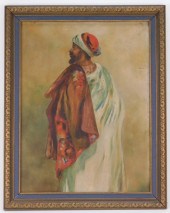 ORIENTALIST MIDDLE EASTERN MAN
ORIENTALIST MIDDLE EASTERN MAN PORTRAIT PAINTING ,Early 20th CenturyRealistic painting of a man facing away from the viewer dressed in white with a red swath of fabric over his shoulder decorated with flowers.
ORIENTALIST MIDDLE EASTERN MAN
ORIENTALIST MIDDLE EASTERN MAN PORTRAIT PAINTING ,Early 20th CenturyRealistic painting of a man facing away from the viewer dressed in white with a red swath of fabric over his shoulder decorated with flowers. -
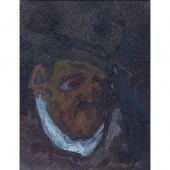 PAINTING, A. MORALES A. Morales
PAINTING, A. MORALES A. Morales (Mexican, 20th century), "Self Portrait," 1965, oil on canvas, signed and dated lower right, titled verso, canvas: 10"h x 8"w, overall (with frame): 12.25"h x 10.25"
PAINTING, A. MORALES A. Morales
PAINTING, A. MORALES A. Morales (Mexican, 20th century), "Self Portrait," 1965, oil on canvas, signed and dated lower right, titled verso, canvas: 10"h x 8"w, overall (with frame): 12.25"h x 10.25" -
 FREDERICK LAMB SELF PORTRAIT
FREDERICK LAMB SELF PORTRAIT PAINTING Massachusetts1861-1936Impressionist depiction of the artist as an older man wearing a blue beret, glasses, and a tan suit with pale blue vest seated outside on an overcast day.
FREDERICK LAMB SELF PORTRAIT
FREDERICK LAMB SELF PORTRAIT PAINTING Massachusetts1861-1936Impressionist depiction of the artist as an older man wearing a blue beret, glasses, and a tan suit with pale blue vest seated outside on an overcast day. -
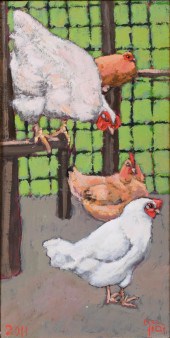 PAINTING OF CHICKENSPAINTING OF
PAINTING OF CHICKENSPAINTING OF CHICKENS,
PAINTING OF CHICKENSPAINTING OF
PAINTING OF CHICKENSPAINTING OF CHICKENS, -
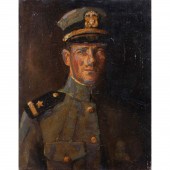 PAINTING, KARL SCHMIDT Karl Schmidt
PAINTING, KARL SCHMIDT Karl Schmidt (American, 1890-1962), "Untitled (Self Portrait)," oil on canvas (laid down on board), stamped "Karl Schmidt U. S. Naval Aviation" verso, museum reference numbers: S13.4, board (unframed): 18.5"h x 14.5"w. Provenance: Sale to Benefit the Oakland Museum of California (Oakland, CA).
PAINTING, KARL SCHMIDT Karl Schmidt
PAINTING, KARL SCHMIDT Karl Schmidt (American, 1890-1962), "Untitled (Self Portrait)," oil on canvas (laid down on board), stamped "Karl Schmidt U. S. Naval Aviation" verso, museum reference numbers: S13.4, board (unframed): 18.5"h x 14.5"w. Provenance: Sale to Benefit the Oakland Museum of California (Oakland, CA). -
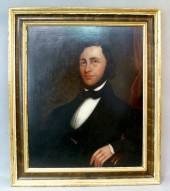 Primitive paint, oil on canvas,
Primitive paint, oil on canvas, relined, portrail of a gentleman with key, 28" x 23" sight, possibly original faux painted and gilt frame, American, 19th c Estimate $800-1,200
Primitive paint, oil on canvas,
Primitive paint, oil on canvas, relined, portrail of a gentleman with key, 28" x 23" sight, possibly original faux painted and gilt frame, American, 19th c Estimate $800-1,200 -
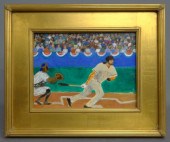 Painting oil on board ''Johnny
Painting oil on board ''Johnny Damon Crushes Yankees Hopes'' by Larry Zingale (self taught artist has had six one man shows in N.Y.C. he has been recognized as ''one of the outstanding self taught artists of the twentieth century'' in ''American folk art in the 20th'' (Rizzoli New York). His paintings have sold at Sotheby's in N.Y. and he is listed in ''Who's Who In American Art''.
Painting oil on board ''Johnny
Painting oil on board ''Johnny Damon Crushes Yankees Hopes'' by Larry Zingale (self taught artist has had six one man shows in N.Y.C. he has been recognized as ''one of the outstanding self taught artists of the twentieth century'' in ''American folk art in the 20th'' (Rizzoli New York). His paintings have sold at Sotheby's in N.Y. and he is listed in ''Who's Who In American Art''. -
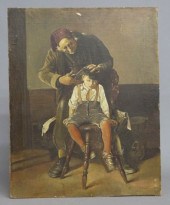 Painting oil on masonite man giving
Painting oil on masonite man giving boy haircut. Unframed. 15 1/2'' x 20''.
Painting oil on masonite man giving
Painting oil on masonite man giving boy haircut. Unframed. 15 1/2'' x 20''. -
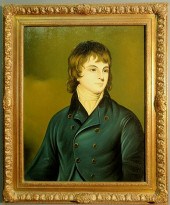 Oil on canvas portrait of a young
Oil on canvas portrait of a young man 20th c. 29"x21.5"
Oil on canvas portrait of a young
Oil on canvas portrait of a young man 20th c. 29"x21.5" -
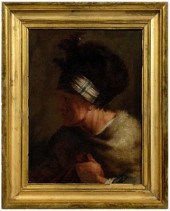 Painting, follower of Piazzetta,
Painting, follower of Piazzetta, portrait of a man wearing a fur and fabric hat and fur wrap, unsigned, follower of Giovanni Battista Piazzetta, Italian, 1682-1754, oil on canvas, inscribed verso "A Polish Tronie(?) c. 1740 Circle of Piazzetta", 18-7/8 x 14-1/8 in.; 19th century gilt wood frame. Restretched on new stretcher, lined with wax and linen, retouch with 15 percent of surface affected, crackle, flaking, overcleaning (mostly of face); frame partially resurfaced, abrasions.
Painting, follower of Piazzetta,
Painting, follower of Piazzetta, portrait of a man wearing a fur and fabric hat and fur wrap, unsigned, follower of Giovanni Battista Piazzetta, Italian, 1682-1754, oil on canvas, inscribed verso "A Polish Tronie(?) c. 1740 Circle of Piazzetta", 18-7/8 x 14-1/8 in.; 19th century gilt wood frame. Restretched on new stretcher, lined with wax and linen, retouch with 15 percent of surface affected, crackle, flaking, overcleaning (mostly of face); frame partially resurfaced, abrasions. -
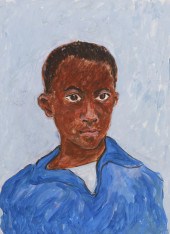 Portrait painting of a young man,
Portrait painting of a young man, gouache on board, unsigned, 15 1/2" x 11 1/2" sight, 17 1/2" x 13 1/2" framed
Portrait painting of a young man,
Portrait painting of a young man, gouache on board, unsigned, 15 1/2" x 11 1/2" sight, 17 1/2" x 13 1/2" framed -
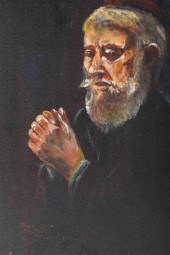 Framed oil on canvas painting,
Framed oil on canvas painting, depicting seated man folding hands; 20" x 24" (approx.)
Framed oil on canvas painting,
Framed oil on canvas painting, depicting seated man folding hands; 20" x 24" (approx.) -
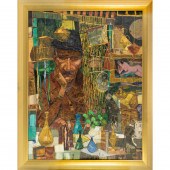 PAINTING, GEORGE RUSSIN George
PAINTING, GEORGE RUSSIN George Russin (American, 1910-2010), Portrait of a Man with Decor, oil on board, signed lower right, overall (with frame): 29.5"h x 23.5"w
PAINTING, GEORGE RUSSIN George
PAINTING, GEORGE RUSSIN George Russin (American, 1910-2010), Portrait of a Man with Decor, oil on board, signed lower right, overall (with frame): 29.5"h x 23.5"w -
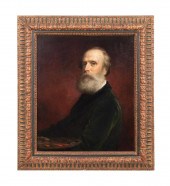 DANIEL HUNTINGTON, 'SELF PORTRAIT',
DANIEL HUNTINGTON, 'SELF PORTRAIT', O/C, 1883 Daniel Huntington (American 1816-1906), 'Self Portrait', 1883, oil on canvas, half length portrait depicting the artist holding a palette and confronting the viewer with his gaze, signed lower right, "D. Huntington, Seville, 1883", framed. Approximate dimensions: Canvas h. 30.25", w. 25"; Overall h. 40", w. 34.5", d. 2.75"
DANIEL HUNTINGTON, 'SELF PORTRAIT',
DANIEL HUNTINGTON, 'SELF PORTRAIT', O/C, 1883 Daniel Huntington (American 1816-1906), 'Self Portrait', 1883, oil on canvas, half length portrait depicting the artist holding a palette and confronting the viewer with his gaze, signed lower right, "D. Huntington, Seville, 1883", framed. Approximate dimensions: Canvas h. 30.25", w. 25"; Overall h. 40", w. 34.5", d. 2.75" -
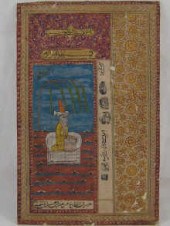 A painting of a man resting beneath
A painting of a man resting beneath a tree gilt decoration and Islamic painted and stamped calligraphy later card backing. 17 x 27 cm.
A painting of a man resting beneath
A painting of a man resting beneath a tree gilt decoration and Islamic painted and stamped calligraphy later card backing. 17 x 27 cm. -
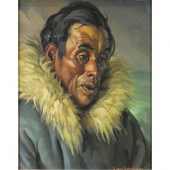 PAINTING, CHRISTIAN VON SCHNEIDAU
PAINTING, CHRISTIAN VON SCHNEIDAU Christian Von Schneidau (American/Swedish, 1893-1976), Portrait of a Man in Fur, oil on canvas, signed lower right, overall (with frame): 28.5"h x 24.5"w. Provenance: Property of a prominent Hillsborough, CA estate.
PAINTING, CHRISTIAN VON SCHNEIDAU
PAINTING, CHRISTIAN VON SCHNEIDAU Christian Von Schneidau (American/Swedish, 1893-1976), Portrait of a Man in Fur, oil on canvas, signed lower right, overall (with frame): 28.5"h x 24.5"w. Provenance: Property of a prominent Hillsborough, CA estate. -
 PAUL GORKA (american b. 1931)
PAUL GORKA (american b. 1931) SELF-PORTRAITS Ink and watercolor on paper 34 x 58 in. Good
PAUL GORKA (american b. 1931)
PAUL GORKA (american b. 1931) SELF-PORTRAITS Ink and watercolor on paper 34 x 58 in. Good -
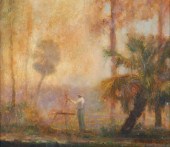 CHRISTOPHER STILL, O/B, ARTIST
CHRISTOPHER STILL, O/B, ARTIST PAINTINGOil on board painting by Christopher Still (American, 20th) depicting a self-portrait of the artist in a wooded landscape. Signed and dated 1997. Titled "Artist Painting En Plein Air." Board measures 7" x 8", framed to 12" x 13". This item will need to be shipped by a packing company of your choice. We maintain a list of reliable shippers, or you may choose your own. shipping info This item will need to be shipped by a packing company of your choice. We maintain a list of reliable shippers, or you may choose your own.
CHRISTOPHER STILL, O/B, ARTIST
CHRISTOPHER STILL, O/B, ARTIST PAINTINGOil on board painting by Christopher Still (American, 20th) depicting a self-portrait of the artist in a wooded landscape. Signed and dated 1997. Titled "Artist Painting En Plein Air." Board measures 7" x 8", framed to 12" x 13". This item will need to be shipped by a packing company of your choice. We maintain a list of reliable shippers, or you may choose your own. shipping info This item will need to be shipped by a packing company of your choice. We maintain a list of reliable shippers, or you may choose your own. -
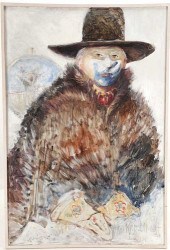 ROBERT DICKENS (1931-2022)
ROBERT DICKENS (1931-2022) SELF-PORTRAIT PAINTINGFeatured in this lot is an original oil on canvas self-portrait painting done by Robert Lee Dickens in 1984. Dickens was born on April 5, 1931, in Chicago, Illinois, and was the son of Robert and Ruth Dickens, the owners of Dickens Design in Chicago. His mother, Ruth, was the first woman race car driver and raced from 1940 to 1953. Robert Dickens was a student at the University of Colorado from 1949 to 1950, and before that, he was an apprentice designer at Robert Sidney Dickens & Associate in Chicago in 1948. Robert Lee Dickens has been listed as a noteworthy design executive by Marquis' Who's Who. He passed away in 2022. The painting is a self-portrait of Robert Dickens himself and shows him with his iconic blue hand print paint on his face. He earned the name from his friends at a pow-wow, after he followed the tradition of painting his face before going into battle. He painted a small blue hand print on his check before dancing which earned him the name Little Blue Hand. The painting shows vivid, bold colors of blue, red, orange, brown, white, yellow and purple. In the bottom left hand corner, the artist's signature reads, "Dickens 84". In the bottom right hand corner, it reads "Kale Lamah" or "Kyle Lamah / Laman". The painting is set in a large white wooden frame. The painting and frame show good condition with the frame displaying some slight wear from use, but no obvious signs of damage are noted. The painting measures 61" L x 41" W.*
ROBERT DICKENS (1931-2022)
ROBERT DICKENS (1931-2022) SELF-PORTRAIT PAINTINGFeatured in this lot is an original oil on canvas self-portrait painting done by Robert Lee Dickens in 1984. Dickens was born on April 5, 1931, in Chicago, Illinois, and was the son of Robert and Ruth Dickens, the owners of Dickens Design in Chicago. His mother, Ruth, was the first woman race car driver and raced from 1940 to 1953. Robert Dickens was a student at the University of Colorado from 1949 to 1950, and before that, he was an apprentice designer at Robert Sidney Dickens & Associate in Chicago in 1948. Robert Lee Dickens has been listed as a noteworthy design executive by Marquis' Who's Who. He passed away in 2022. The painting is a self-portrait of Robert Dickens himself and shows him with his iconic blue hand print paint on his face. He earned the name from his friends at a pow-wow, after he followed the tradition of painting his face before going into battle. He painted a small blue hand print on his check before dancing which earned him the name Little Blue Hand. The painting shows vivid, bold colors of blue, red, orange, brown, white, yellow and purple. In the bottom left hand corner, the artist's signature reads, "Dickens 84". In the bottom right hand corner, it reads "Kale Lamah" or "Kyle Lamah / Laman". The painting is set in a large white wooden frame. The painting and frame show good condition with the frame displaying some slight wear from use, but no obvious signs of damage are noted. The painting measures 61" L x 41" W.* -
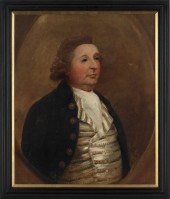 Oil on canvas portrait of a
Oil on canvas portrait of a gentleman 19th c. 30" x 24". ?
Oil on canvas portrait of a
Oil on canvas portrait of a gentleman 19th c. 30" x 24". ? -
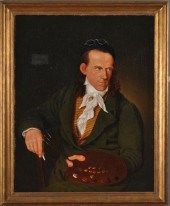 AMERICAN SCHOOL: PORTRAIT OF A
AMERICAN SCHOOL: PORTRAIT OF A PAINTER WITH PALETTE AND BRUSHES Oil on canvas relined; 34 x 26 3/8 in. Provenance: The Fresno Metropolitan Museum of Art and Science Fresno CA.
AMERICAN SCHOOL: PORTRAIT OF A
AMERICAN SCHOOL: PORTRAIT OF A PAINTER WITH PALETTE AND BRUSHES Oil on canvas relined; 34 x 26 3/8 in. Provenance: The Fresno Metropolitan Museum of Art and Science Fresno CA. -
 PABLO PICASSO. "SELF PORTRAIT
PABLO PICASSO. "SELF PORTRAIT WITH BONSON," GICLEE (Spanish, 1881-1973). Color giclee on paper, ed. 359/900, signed in print, blind stamp lr, limited edition of 900, from the Artwork Registry's "Illustrations Avant-Garde European Art of the 1900's" sheet size: 8 x 10 in., framed.
PABLO PICASSO. "SELF PORTRAIT
PABLO PICASSO. "SELF PORTRAIT WITH BONSON," GICLEE (Spanish, 1881-1973). Color giclee on paper, ed. 359/900, signed in print, blind stamp lr, limited edition of 900, from the Artwork Registry's "Illustrations Avant-Garde European Art of the 1900's" sheet size: 8 x 10 in., framed. -
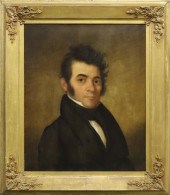 Oil on canvas portrait of a young
Oil on canvas portrait of a young gentleman, circa 1830, mounted in a period gilt frame, sight 27"h x 22"w
Oil on canvas portrait of a young
Oil on canvas portrait of a young gentleman, circa 1830, mounted in a period gilt frame, sight 27"h x 22"w -
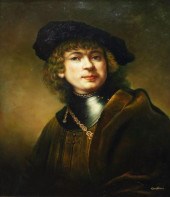 SELF-PORTRAIT AS A YOUNG MAN
SELF-PORTRAIT AS A YOUNG MAN AFTER REMBRANDTFramed oil on canvas painting, Self-portrait as a Young Man, after the original by Rembrandt van Rijn (Amsterdam, 1606-1669), signed lower right Donaldson, sight: approx 23.5"h, 19.5"w, overall: approx 31"h, 27"w, 13lbs
SELF-PORTRAIT AS A YOUNG MAN
SELF-PORTRAIT AS A YOUNG MAN AFTER REMBRANDTFramed oil on canvas painting, Self-portrait as a Young Man, after the original by Rembrandt van Rijn (Amsterdam, 1606-1669), signed lower right Donaldson, sight: approx 23.5"h, 19.5"w, overall: approx 31"h, 27"w, 13lbs -
 PAINTING, HEIMO ZOBERNIG Heimo
PAINTING, HEIMO ZOBERNIG Heimo Zobernig (Austrian, b. 1958), "Untitled," 2006, acrylic on canvas, signed, titled, and dated verso, canvas (unframed): 39.5"h x 39.5"w. Provenance: Purchased from Friedrich Petzel Gallery, New York, NY.
PAINTING, HEIMO ZOBERNIG Heimo
PAINTING, HEIMO ZOBERNIG Heimo Zobernig (Austrian, b. 1958), "Untitled," 2006, acrylic on canvas, signed, titled, and dated verso, canvas (unframed): 39.5"h x 39.5"w. Provenance: Purchased from Friedrich Petzel Gallery, New York, NY. -
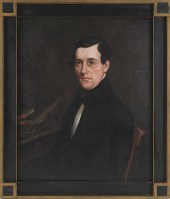 Oil on canvas portrait of a
Oil on canvas portrait of a gentleman 19th c. seated at a writing desk 30" x 25". ?
Oil on canvas portrait of a
Oil on canvas portrait of a gentleman 19th c. seated at a writing desk 30" x 25". ? -
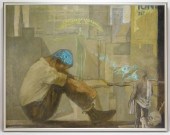 URBAN GENRE SCI FI STREET SCENE
URBAN GENRE SCI FI STREET SCENE PAINTING ,20th CenturyDepicts a young man with his head resting on his knees in an urban environment, a futuristic glowing blue head piece projects a human form glowing forms leading to a skull and multi armed figure.
URBAN GENRE SCI FI STREET SCENE
URBAN GENRE SCI FI STREET SCENE PAINTING ,20th CenturyDepicts a young man with his head resting on his knees in an urban environment, a futuristic glowing blue head piece projects a human form glowing forms leading to a skull and multi armed figure. -
 Oil on canvas portrait of a
Oil on canvas portrait of a gentleman 19th c. 28" x 22". ?
Oil on canvas portrait of a
Oil on canvas portrait of a gentleman 19th c. 28" x 22". ? -
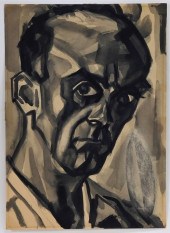 OTTO PLAUG MODERN SELF PORTRAIT INK
OTTO PLAUG MODERN SELF PORTRAIT INK PAINTING New York, Germany,1898-2000Depicts a 3/4 view bust of a stern man with thick brow and laugh lines. Believed to have been a self portrait of the artist per estate This drawing was removed from a portfolio of 30 works to which we will be selling over time with examples spanning from the early 1900's to his later modernist works of the 1940's during WWII.
OTTO PLAUG MODERN SELF PORTRAIT INK
OTTO PLAUG MODERN SELF PORTRAIT INK PAINTING New York, Germany,1898-2000Depicts a 3/4 view bust of a stern man with thick brow and laugh lines. Believed to have been a self portrait of the artist per estate This drawing was removed from a portfolio of 30 works to which we will be selling over time with examples spanning from the early 1900's to his later modernist works of the 1940's during WWII. -
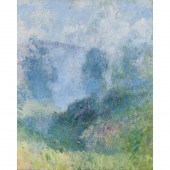 PAINTING, GUY ROSE Guy Rose
PAINTING, GUY ROSE Guy Rose (American, 1867-1925), "Rising Mists," oil on canvas, titled on a handwritten label verso, canvas: 28.5"h x 23.75"w, overall (with frame): 36.5"h x 31.75"w. Provenance: Earl Stendahl, Los Angeles, CA by 1926; by descent to present owner. Exhibited: Los Angeles, CA, Stendahl Art Galleries, Guy Rose Memorial Exhibition, February 16 - March 14, 1926, p. 56, no. 87, illustrated.
PAINTING, GUY ROSE Guy Rose
PAINTING, GUY ROSE Guy Rose (American, 1867-1925), "Rising Mists," oil on canvas, titled on a handwritten label verso, canvas: 28.5"h x 23.75"w, overall (with frame): 36.5"h x 31.75"w. Provenance: Earl Stendahl, Los Angeles, CA by 1926; by descent to present owner. Exhibited: Los Angeles, CA, Stendahl Art Galleries, Guy Rose Memorial Exhibition, February 16 - March 14, 1926, p. 56, no. 87, illustrated. -
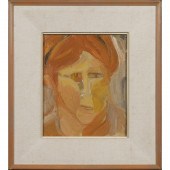 PAINTING, VICTOR MOSCOSO Victor
PAINTING, VICTOR MOSCOSO Victor Moscoso (American, b. 1936), Portrait, 1960, oil on canvas, signed and dated lower left, overall (with frame): 17.5"h x 16"w. Provenance: Private collection of composer and art dealer Robert Aichele.
PAINTING, VICTOR MOSCOSO Victor
PAINTING, VICTOR MOSCOSO Victor Moscoso (American, b. 1936), Portrait, 1960, oil on canvas, signed and dated lower left, overall (with frame): 17.5"h x 16"w. Provenance: Private collection of composer and art dealer Robert Aichele. -
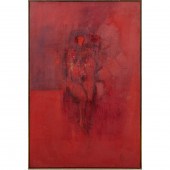 PAINTING, GEORGE VIHOS George Vihos
PAINTING, GEORGE VIHOS George Vihos (American, b. 1937), "The Manipulator," oil on canvas, signed lower right, signed and titled verso, canvas: 50"h x 32"w, overall (with frame): 51"h x 33"w
PAINTING, GEORGE VIHOS George Vihos
PAINTING, GEORGE VIHOS George Vihos (American, b. 1937), "The Manipulator," oil on canvas, signed lower right, signed and titled verso, canvas: 50"h x 32"w, overall (with frame): 51"h x 33"w -
 A Persian Painting of a Young
A Persian Painting of a Young Man, 19th Century or Earlier Colour on paper, framed sight 13.4 x 7.9 in — 34 x 20 cm
A Persian Painting of a Young
A Persian Painting of a Young Man, 19th Century or Earlier Colour on paper, framed sight 13.4 x 7.9 in — 34 x 20 cm -
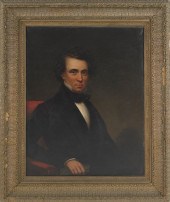 Oil on canvas portrait of a
Oil on canvas portrait of a gentleman 19th c. 34" x 27". ?
Oil on canvas portrait of a
Oil on canvas portrait of a gentleman 19th c. 34" x 27". ? -
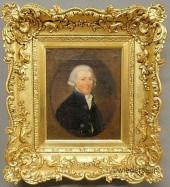 Oil on canvas portrait of a
Oil on canvas portrait of a gentleman late 18th c. wearing a blue coat and mounted in an ornate gilt frame. 10.5''x8.5''
Oil on canvas portrait of a
Oil on canvas portrait of a gentleman late 18th c. wearing a blue coat and mounted in an ornate gilt frame. 10.5''x8.5'' -
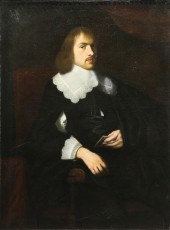 PAINTING, ATTRIBUTED TO GEORGE
PAINTING, ATTRIBUTED TO GEORGE JAMESONE Attributed to George Jamesone (British, c. 1587-1644), Portrait of a Gentleman, oil on canvas, unsigned, numbered 450 verso, artist plaque affixed to frame lower center, canvas: 48"h x 36"w, overall (with frame): 55.75"h x 43.5"w
PAINTING, ATTRIBUTED TO GEORGE
PAINTING, ATTRIBUTED TO GEORGE JAMESONE Attributed to George Jamesone (British, c. 1587-1644), Portrait of a Gentleman, oil on canvas, unsigned, numbered 450 verso, artist plaque affixed to frame lower center, canvas: 48"h x 36"w, overall (with frame): 55.75"h x 43.5"w
...many more examples with full details are available to our members - Learn more


